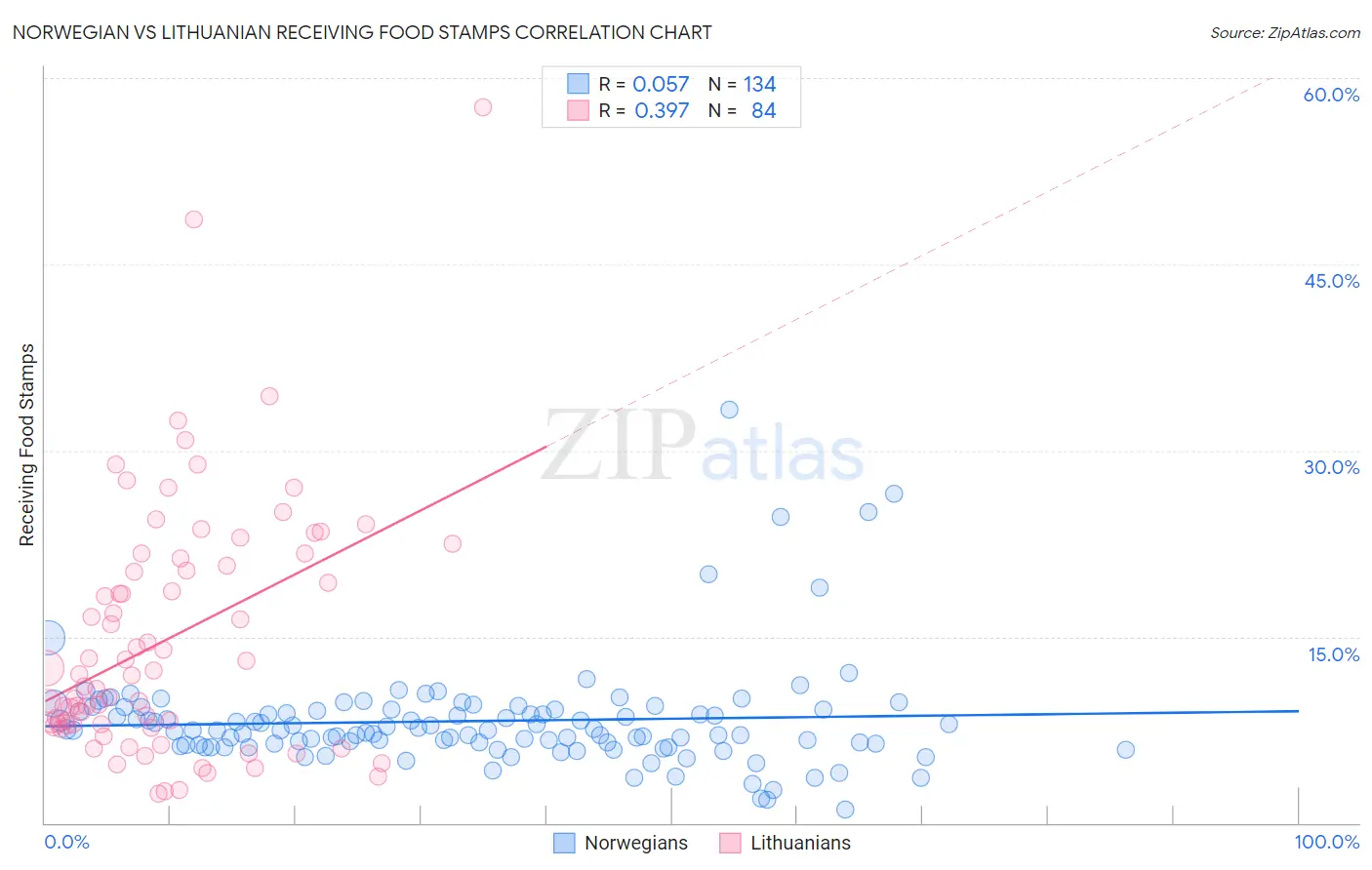Norwegian vs Lithuanian Receiving Food Stamps
COMPARE
Norwegian
Lithuanian
Receiving Food Stamps
Receiving Food Stamps Comparison
Norwegians
Lithuanians
9.0%
RECEIVING FOOD STAMPS
99.9/ 100
METRIC RATING
15th/ 347
METRIC RANK
9.7%
RECEIVING FOOD STAMPS
99.4/ 100
METRIC RATING
50th/ 347
METRIC RANK
Norwegian vs Lithuanian Receiving Food Stamps Correlation Chart
The statistical analysis conducted on geographies consisting of 530,518,584 people shows a slight positive correlation between the proportion of Norwegians and percentage of population receiving government assistance and/or food stamps in the United States with a correlation coefficient (R) of 0.057 and weighted average of 9.0%. Similarly, the statistical analysis conducted on geographies consisting of 420,339,892 people shows a mild positive correlation between the proportion of Lithuanians and percentage of population receiving government assistance and/or food stamps in the United States with a correlation coefficient (R) of 0.397 and weighted average of 9.7%, a difference of 7.9%.

Receiving Food Stamps Correlation Summary
| Measurement | Norwegian | Lithuanian |
| Minimum | 1.1% | 2.4% |
| Maximum | 33.3% | 57.6% |
| Range | 32.2% | 55.2% |
| Mean | 8.2% | 14.8% |
| Median | 7.5% | 11.9% |
| Interquartile 25% (IQ1) | 6.3% | 7.9% |
| Interquartile 75% (IQ3) | 9.1% | 21.0% |
| Interquartile Range (IQR) | 2.8% | 13.1% |
| Standard Deviation (Sample) | 4.3% | 10.0% |
| Standard Deviation (Population) | 4.3% | 10.0% |
Similar Demographics by Receiving Food Stamps
Demographics Similar to Norwegians by Receiving Food Stamps
In terms of receiving food stamps, the demographic groups most similar to Norwegians are Immigrants from Japan (9.0%, a difference of 0.27%), Immigrants from Scotland (9.0%, a difference of 0.43%), Maltese (8.9%, a difference of 0.66%), Bulgarian (8.9%, a difference of 0.79%), and Danish (9.0%, a difference of 0.88%).
| Demographics | Rating | Rank | Receiving Food Stamps |
| Burmese | 99.9 /100 | #8 | Exceptional 8.6% |
| Immigrants | Korea | 99.9 /100 | #9 | Exceptional 8.7% |
| Immigrants | South Central Asia | 99.9 /100 | #10 | Exceptional 8.8% |
| Okinawans | 99.9 /100 | #11 | Exceptional 8.9% |
| Cypriots | 99.9 /100 | #12 | Exceptional 8.9% |
| Bulgarians | 99.9 /100 | #13 | Exceptional 8.9% |
| Maltese | 99.9 /100 | #14 | Exceptional 8.9% |
| Norwegians | 99.9 /100 | #15 | Exceptional 9.0% |
| Immigrants | Japan | 99.9 /100 | #16 | Exceptional 9.0% |
| Immigrants | Scotland | 99.9 /100 | #17 | Exceptional 9.0% |
| Danes | 99.9 /100 | #18 | Exceptional 9.0% |
| Immigrants | Hong Kong | 99.8 /100 | #19 | Exceptional 9.1% |
| Latvians | 99.8 /100 | #20 | Exceptional 9.1% |
| Luxembourgers | 99.8 /100 | #21 | Exceptional 9.1% |
| Immigrants | Australia | 99.8 /100 | #22 | Exceptional 9.2% |
Demographics Similar to Lithuanians by Receiving Food Stamps
In terms of receiving food stamps, the demographic groups most similar to Lithuanians are Asian (9.7%, a difference of 0.18%), Immigrants from South Africa (9.7%, a difference of 0.19%), Tongan (9.7%, a difference of 0.21%), Immigrants from Czechoslovakia (9.6%, a difference of 0.25%), and Russian (9.6%, a difference of 0.27%).
| Demographics | Rating | Rank | Receiving Food Stamps |
| Croatians | 99.5 /100 | #43 | Exceptional 9.6% |
| Immigrants | Denmark | 99.4 /100 | #44 | Exceptional 9.6% |
| Immigrants | Belgium | 99.4 /100 | #45 | Exceptional 9.6% |
| Australians | 99.4 /100 | #46 | Exceptional 9.6% |
| Indians (Asian) | 99.4 /100 | #47 | Exceptional 9.6% |
| Russians | 99.4 /100 | #48 | Exceptional 9.6% |
| Immigrants | Czechoslovakia | 99.4 /100 | #49 | Exceptional 9.6% |
| Lithuanians | 99.4 /100 | #50 | Exceptional 9.7% |
| Asians | 99.3 /100 | #51 | Exceptional 9.7% |
| Immigrants | South Africa | 99.3 /100 | #52 | Exceptional 9.7% |
| Tongans | 99.3 /100 | #53 | Exceptional 9.7% |
| Swiss | 99.3 /100 | #54 | Exceptional 9.7% |
| Immigrants | Switzerland | 99.3 /100 | #55 | Exceptional 9.7% |
| Immigrants | Canada | 99.3 /100 | #56 | Exceptional 9.7% |
| Greeks | 99.3 /100 | #57 | Exceptional 9.7% |